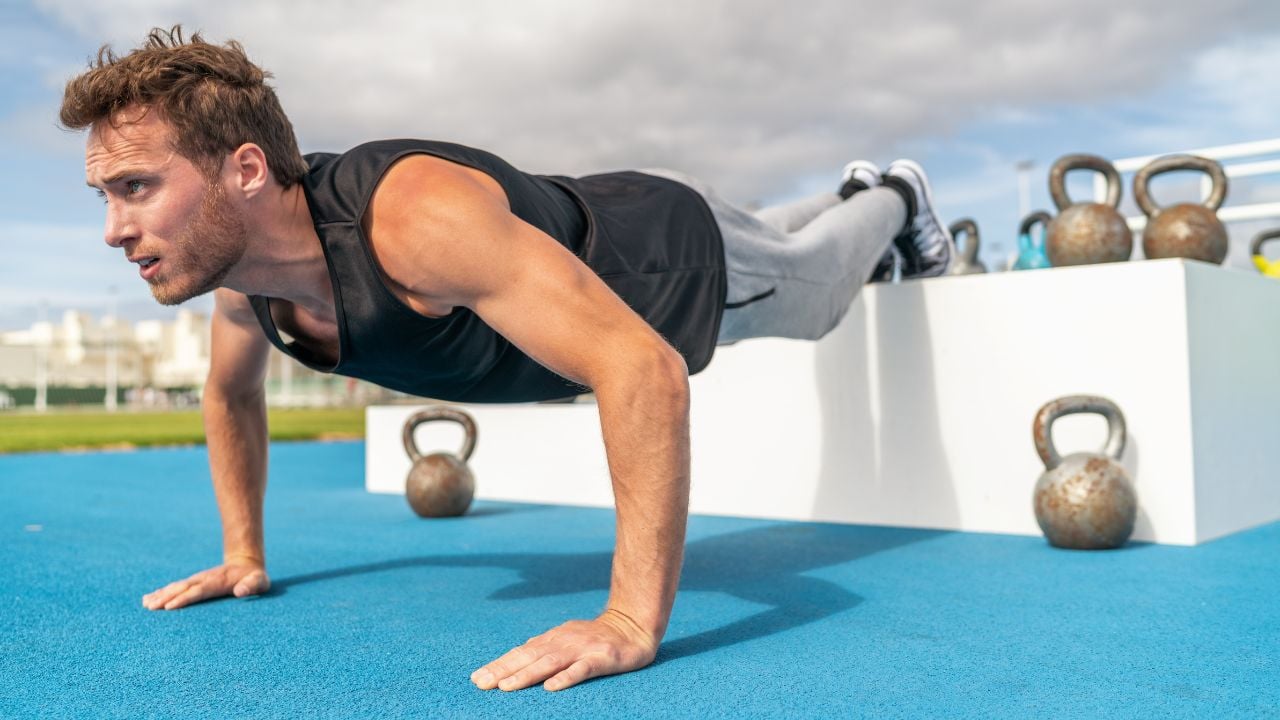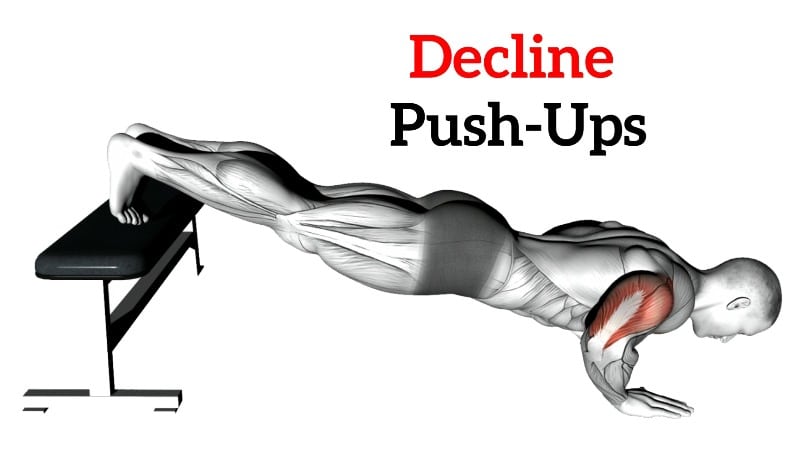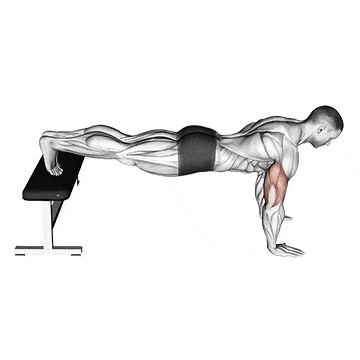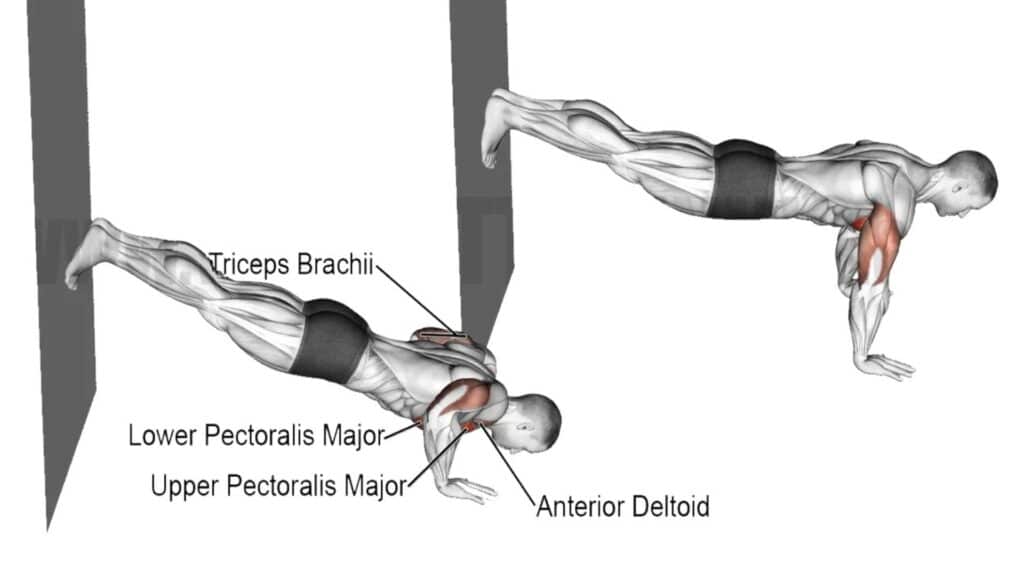Push-ups are a great way to strengthen your chest muscles and train your shoulder and triceps.
A decline push up is a more difficult version of a regular push-up where you put your feet higher than your hands. It’s perfect for intermediate and pros who want to build upper body strength.
You can easily perform decline push-ups by using a simple elevated surface such as a bench, step, or even a staircase.
It can help to build additional strength, muscle mass and improve weak areas in your upper chest.
In this beginner’s guide, we’ll cover everything you need to know about:
- How to do decline push-ups with proper form,
- Muscles worked During It.
- Variations to make them more or less challenging.

- What Are Decline Push-Ups?
- Decline Push Up Muscles Worked
- How To Do Decline Push-Up For Upper Chest
- Proper Angle To Do Decline Pushups
- Decline Push-Ups Modifications (Make It Easier Or Harder)
- Make it easier
- Make it harder
- 1. Feet On Stability Ball Push-Up
- 2. Wall Decline Push Up
- 3. Single-Leg Decline Push-Up
- 4. Decline Clap Push-Up
- Training Tips And Techniques
- Benefits Of Decline Push-Ups
- FAQs
- Decline Push-Up Vs Standard Push-Up
- Do Decline Push Ups Work Upper Chest
- How The Decline Push Up Works The Upper Chest?
- Incline Push-Ups Vs Decline Push-Ups
- When To Perform The Decline Push Up
- How Many Decline Push-Ups Should I Do
- Takeaways
- References
What Are Decline Push-Ups?
Decline push-ups are a bodyweight exercise that puts special emphasis on the muscles in your upper chest.
You should place your foot on a stable surface such as a table, desk, or wall or other elevated surface when you do the decline push-up.
The height of the decline can be as little as an inch or as much as a couple of feet. You can adjust the bench height to make your workout more intense.
With a standard push up, you lift about 70% of your own bodyweight.
As a decline variation, when you perform push-ups with your feet high, you actually push up even more of your weight. This makes the decline variation more efficient and harder than the standard push-up variation.
And, of course, the harder it will be the higher you place your feet.

Know More: Push-Ups: How-To, Muscle Worked, Benefit, Variations
Decline Push Up Muscles Worked
Depending on the degree to which you perform this exercise, it will be the muscles that are worked and with greater or lesser intensity. The main muscles involved in push-ups are:
- Main muscles during decline push-ups: Upper Chest, Anterior deltoids (shoulder muscle), and triceps.
- Secondary muscles during decline pushups: Lower chest, lateral deltoid, serratus, trapezius, and core muscles (abs, lumbar, gluteal, pelvic, and deep spinal muscles).
Because of your body’s position, the decline push up emphasizes your upper chest (clavicular head of the pectoral) while also working your front deltoids, triceps, and serratus anterior.

How To Do Decline Push-Up For Upper Chest
- Start by finding a stable elevated surface like a bench, box, or step.
- The higher the surface, the more challenging the exercise will be.
- Place your feet on the elevated surface and your hands on the ground, slightly wider than shoulder-width apart.
- Your body should form a straight line from your heels to your head.
- Tighten your core muscles to keep your body straight and stable. Avoid letting your hips sag or stick up in the air.
- Slowly lower your body by bending your elbows until your chest is just above the ground.
- Keep your elbows at about a 45-degree angle to your body.
- Press back up to the starting position by extending your arms fully.
- Complete 3–4 sets of 8 to 20 repetitions.

Proper Angle To Do Decline Pushups
Decline push-ups are one of the best upper chest exercises, but there’s one major problem: the front deltoid likes to dominate the movement, which prevents us from getting the maximum benefit out of it.
When the angle is steep, the upper chest gets worked. However, if you raise the elevation too high, the shoulders will begin doing the primary work, and the chest will only act as assisting muscles.
This is when you do Pike push ups and handstand push-ups.
For proper stimulation of the upper chest muscles, keep the downward angle at 30–45 degrees.
If you want to increase the angle further, please avoid going beyond 60 degrees, as this will shift the focus to the anterior deltoid.

Decline Push-Ups Modifications (Make It Easier Or Harder)
If you want to make decline pushups easier, place your feet on a less inclined surface. Anyone can do this version because you’re not lifting a large percentage of your bodyweight.
To make decline pushups harder, you can use any of the variations listed below, which increase the angle of inclination or using stability ball decline push-ups
You can change the decline pushups to fit your fitness level, likes, and goals.
Make it easier
The difficulty of the decline push-up can be changed by changing the height of the object you are putting your feet on. If you want to make decline pushups easier, try placing your feet on a less inclined surface.
Make it harder
When you can do 15-20 basic decline pushups in a row, or you may want to increase the intensity of push-ups, then incline the bench height or try doing the decline push up on a less stable surface such as a stability ball pushup, or with one arm.
1. Feet On Stability Ball Push-Up
If you’re looking for a way to get more creative with your upper chest workout, why not try push-up with your feet on a Swiss ball.
The unstable surface of the stability ball forces the upper chest muscles to work harder.
It is a progression of the decline push-up that targets the chest, shoulders, and triceps while engaging the core. The exercise emphasizes the upper chest and shoulders.

How To Do It
- Lie face-down on the ball with your arms supporting you in push-up position.
- Roll forward until your pelvis and thighs are off the ball and position your feet on top of the ball.
- Your hands should be directly beneath your shoulders. And your body should form a straight line from head to heals.
- Breathe in as you lower yourself by bending your arms until your elbows form a 90-degree angle.
- Use your core muscles to stabilize yourself.
- Pause for one to two seconds at the bottom before breathing out and using your arms to push you up to the starting position.
2. Wall Decline Push Up
The Wall decline push-up is a variation of the decline push-up which is challenging and requires coordination and balance. It is appropriate for advanced learners.

How To Do It
- Placed your hands firmly on the floor and spaced slightly wider than shoulder-width apart. Place your legs against the wall.
- Now raise yourself off the ground, straightening your elbows and your arms. Keep your elbows close to your body.
- Raise until your elbows are almost near to locked, and pause for a moment at the top of the movement.
- Now lower your body slowly and steadily until your chest is close to the ground.
- Complete the desired number of reps.
3. Single-Leg Decline Push-Up
Instead of keeping both feet on the step or bench, lift one a few inches in the air. This forces your upper body to work harder to stabilize you during the move.
4. Decline Clap Push-Up
Turn this movement into a more explosive exercise by adding a clap. When pushing up to the position where your arms are fully extended, push with enough force to raise your hands off the floor.
Clap them together before returning them to the ground and lowering back down.
Training Tips And Techniques
Follow the proper foam and techniques to get the most out of this move.
- For the decline push-ups, begin by performing 2–3 sets of 6–8 repetitions. Add more reps and sets as you build strength.
- Choose the exercises as per your fitness levels. And also choice your sets and repetitions based on your ability to maintain good technique throughout all sets and repetitions.
- Always keep the elbows slightly bent. Locking your elbows at the top of the movement puts too much stress on the joints and can lead to strain or injury.
- Pay extra attention to your form and emphasize quality over quantity to improve your upper-body strength.
- Do not let your lower back sag or your butt rise. Ensure your body is straight and rigid.
- Slow down all of your movements and really stay focused on your form.
- The core and glutes should be contracted during the exercise.
- Your neck should be in line with your body, not tilted up, which could strain the neck.
- If you are having trouble perfecting your form for this decline push up, it can be helpful to break down the movement, regress, and work on the foundation.
- To see continual progress and build body strength, incorporate proper warm-ups, rest, and nutrition into your exercise program.
- Rest for 24 to 48 hours before training the same muscle groups to allow sufficient recovery.
Benefits Of Decline Push-Ups
The decline push-ups exercises are a good choice for training: Benefits of regularly performing decline push-ups include:
- The decline push-up is an advanced upper body exercise that targets the muscles of the chest, shoulders, back, and arms.
- Decline Push-ups will improve muscular endurance within the upper body, strengthen both muscles and bones.
- Research shows that decline push-ups may improve the performance of athletes.
- Doing a push-ups can be a powerful full-body workout and help to burn more calories.
- As you’ll be moving your full body around, these drills will improve your metabolism, get you to burn more fat and help you achieve that mean and lean look.
- Decline Push-ups are also considered a compound exercise because they require multiple muscle groups to be worked simultaneously.
- Are you looking to build a home gym? You don’t need any special equipment to practice the push-ups workout. All you need is the right technique and some willpower.
FAQs
Decline Push-Up Vs Standard Push-Up
Standard Push-ups are a compound strength-training exercise that involves raising and lowering the body using the arms while facing down in a prone, horizontal position.
The classic push-up has survived the test of time and is the single most efficient exercise to simultaneously strengthen the chest, arms, deltoid, lower back, abs and glutes.
Decline push-ups are harder than standard push-ups because of the angle at which the exercise has to be done. The decline position means that more of the upper chest, shoulder muscles, tricep worked.
Do Decline Push Ups Work Upper Chest
The decline push up is one of the best pushups for the upper chest. You will be expected to decline at a certain angle to complete this move. Declination helps target the upper chest muscles.
How The Decline Push Up Works The Upper Chest?
The decline push up requires that you place your feet very high. When you are in a decline position, you are putting more weight on the clavicular (upper portion) head of the chest. This allows you to work the upper chest more intensely.
Incline Push-Ups Vs Decline Push-Ups
Incline pushups are easier than basic pushups, while decline pushups are harder.
Both variations work your chest, triceps, shoulders, and back muscles. However, because of the angle, the Incline Push Up works your lower chest and back more.
On the other hand, the decline push-up works the upper chest and front shoulders more than the regular or incline variation.
Once you’ve mastered the incline and basic pushups, give the decline push-up a shot. It is an excellent exercise for challenging your upper chest and shoulders.
When To Perform The Decline Push Up
These decline push-ups are a must-have for any chest-focused workout. You should do them at the end of the workout because of their simplicity and good resistance.
Also do the other push-ups to build upper body strength and mass.
- Standard push-ups
- Incline push ups
- Narrow-grip push up
- Pike Ups
- Hindu push ups
How Many Decline Push-Ups Should I Do
For decline push-ups, begin by performing 3–4 sets of 10–20 repetitions, focusing on maintaining good technique.
Takeaways
The decline pushup is a more advanced exercise that takes time to master.
Before trying this move, you’ll want to be able to do regular and incline pushups.
It activate multiple muscle groups throughout your upper body, including your anterior deltoids, pectoralis major, and triceps.
References
- The Biomechanics of the Push-up: https://www.researchgate.net/publication/271794661_The_Biomechanics_of_the_Push-up
- Leaf Group. (n.d.). Push-ups that target the inner chest | livestrong. LIVESTRONG.COM.
https://www.livestrong.com/article/321863-push-ups-that-target-the-inner-chest/ - Ebben WP, Wurm B, Vanderzanden TL, et al. Kinetic analysis of several variations of push-ups. J Strength Cond Res 2011; 25: 2891–2894.
- Hollman JH, Stout JR. Comparison of Muscle-Activation Patterns During the Conventional Push-Up and Perfect· Pushup™ Exercises. The Journal of Strength and Conditioning Research. 2010 Dec;24(12):3352-62.
- Cogley RM, Archambault TA, Fibeger JF, Koverman MM. Comparison of muscle activation using various hand positions during the push-up exercise. Journal of strength and conditioning research. 2005 Aug 1;19(3):628.

Manish brings over 10 years of hands-on experience in weight lifting and fat loss to fitness coaching. He specializes in gym-based training and has a lot of knowledge about exercise, lifting technique, biomechanics, and more.
Through “Fit Life Regime,” he generously shares the insights he’s gained over a decade in the field. His goal is to equip others with the knowledge to start their own fitness journey.
